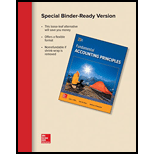
Concept explainers
Concept introduction:
Inventory can be valued at LIFO, FIFO or weighted average method. LIFO means last in first out, in other words the goods which came last can go further first. FIFO means first in first out, in other words the goods which come first can go further first. In both the methods, stock should be valued as last or first stock comes in. while as per weighted average method, remaining stock will be valued at equal rate. In other words whole stock should be totaled and divided by number of weights so that average weight should be found out. This average rate should be multiplied by closing stock.
Requirement 1:
We have to determine the
Requirement 2:
We have to prepare the
Requirement 3:
We have to determine the journal entry for various transactions.
Requirement 4:
We have to determine the ledger accounts.
Requirement 5:
We have to determine the gross profit from sales in july.
Want to see the full answer?
Check out a sample textbook solution
Chapter 20 Solutions
Loose Leaf for Fundamental Accounting Principles
- I need help finding the accurate solution to this general accounting problem with valid methods.arrow_forwardPlease provide the correct solution to this financial accounting question using valid principles.arrow_forwardI am looking for help with this general accounting question using proper accounting standards.arrow_forward
- Please provide the correct answer to this general accounting problem using accurate calculations.arrow_forwardPlease explain the solution to this financial accounting problem with accurate explanations.arrow_forwardPlease explain the correct approach for solving this general accounting question.arrow_forward

 AccountingAccountingISBN:9781337272094Author:WARREN, Carl S., Reeve, James M., Duchac, Jonathan E.Publisher:Cengage Learning,
AccountingAccountingISBN:9781337272094Author:WARREN, Carl S., Reeve, James M., Duchac, Jonathan E.Publisher:Cengage Learning, Accounting Information SystemsAccountingISBN:9781337619202Author:Hall, James A.Publisher:Cengage Learning,
Accounting Information SystemsAccountingISBN:9781337619202Author:Hall, James A.Publisher:Cengage Learning, Horngren's Cost Accounting: A Managerial Emphasis...AccountingISBN:9780134475585Author:Srikant M. Datar, Madhav V. RajanPublisher:PEARSON
Horngren's Cost Accounting: A Managerial Emphasis...AccountingISBN:9780134475585Author:Srikant M. Datar, Madhav V. RajanPublisher:PEARSON Intermediate AccountingAccountingISBN:9781259722660Author:J. David Spiceland, Mark W. Nelson, Wayne M ThomasPublisher:McGraw-Hill Education
Intermediate AccountingAccountingISBN:9781259722660Author:J. David Spiceland, Mark W. Nelson, Wayne M ThomasPublisher:McGraw-Hill Education Financial and Managerial AccountingAccountingISBN:9781259726705Author:John J Wild, Ken W. Shaw, Barbara Chiappetta Fundamental Accounting PrinciplesPublisher:McGraw-Hill Education
Financial and Managerial AccountingAccountingISBN:9781259726705Author:John J Wild, Ken W. Shaw, Barbara Chiappetta Fundamental Accounting PrinciplesPublisher:McGraw-Hill Education





